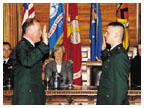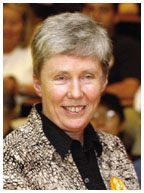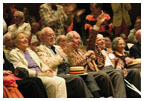July 7, 2004: Notebook
Klawe presents plan to reinvigorate engineering school
Graduating into the Armed Forces

Dean Maria Klawe during her presentation to alumni. (Frank Wojciechowski) |
After nine months of workshops and discussions, Dean Maria Klawe is launching a plan to revamp instruction in the School of Engineering and Applied Science by creating new programs of interdisciplinary study and adding endowed chairs, graduate research fellowships, and new facilities. The plan is meant to encourage all students to understand technology’s role in society, and set new standards in the education of both engineers and nonengineers over the next 10 years, she says.
Klawe explained the plan, which she calls “engineering for a better world,” to a full house of alumni, faculty, and students at the Friend Center May 28. To accomplish the goals, school leaders hope to raise between $400 million and $600 million.
Behind the changes, Klawe says, is the fact that while coursework fits neatly into disciplinary categories, technological problems often do not. Classes reward individual work, but real-world solutions require teamwork and collaboration. And engineering affects professionals in a range of fields, not just engineers. Klawe says Princeton is uniquely positioned to address these issues. “If you go to M.I.T. and talk about engineering, the excitement is about technology,” she says. “At Princeton, you talk about engineering and the university education as a whole, and the excitement is about making the world a better place. It’s a completely different emphasis.”
Specific changes include the addition of an integrated math, physics, and engineering introductory course in the fall of 2006, an expansion of degree programs to provide A.B. degree options in traditional B.S.E. disciplines, and a commitment to bioengineering tracks. The school already offers several interdisciplinary courses, but Klawe says the goal is to make them “part of the fabric of the curriculum” and to enroll more nonengineers. Planned facilities include a building for operations research and financial engineering at the corner of Olden and William Streets, and two other “showcase facilities,” including one for the Princeton Institute for the Science and Technology of Materials.
Princeton’s engineering programs are listed among the top 20 in national rankings, but first-year enrollment in the B.S.E. program has dropped 23 percent since 2002, with a low of 189 students in the 2003—04 freshman class, according to the EQuad News, the school’s quarterly newsletter. Klawe asked Dean of Admission Janet Rapelye to increase the number of engineering concentrators admitted, which Rapelye did for this fall’s entering freshman class. “I also think that the changes we’re going to be making, in terms of the opportunities for engineering students, especially in the freshman year, are going to make a difference,” Klawe says.
Klawe credits Sanjeev Kulkarni and Kyle Vanderlick, the school’s associate deans for academic affairs, for driving the planning process, with assistance from scores of faculty and alumni workshop participants. The same type of collective effort will be important in putting the vision to work. Klawe plans to teach Math 104, the University’s second-semester calculus course, tailoring it to appeal to potential engineers. The class, which used to meet three times a week for one hour, will now meet twice a week for two hours. The extra time will be used by different engineering faculty members to show how calculus is useful in their particular fields, Klawe says.
It is a symbolic example of her hopes for the entire school. “I
want to see our individual faculty members, students, and alumni saying
‘There’s something I can do with this,’” she says.
“We’re putting in motion a sea change where everybody gets
engaged in creating a new vision of engineering.” ![]()
By B.T.

(Photo: Ricardo Barros) |
Reuners filled Richardson Auditorium May 29 for President Tilghman’s
fourth annual conversation with alumni, in which she talked about the
University and the issues it faces. Afterward she fielded questions about
athletics, alcohol, architecture, civic engagement, and diversity. An
alumnus from the Class of 2000 made a case for reinstating the Nude Olympics,
saying that the current University ban implies Harvard students, who annually
streak on their campus in January, are more mature than Princeton students.
Tilghman gave a simple reply: “Nice try.” To read a transcript
of the Tilghman talk,click
here.![]()

The Princeton University Art Museum received an unsolicited addition to its collection June 4, when an anonymous visitor, armed with double-sided tape, installed a painting depicting President Bush with a mixture of acrylic paint, dollar bills, and bodily fluids. Police have linked the incident to a string of similar cases at the National Gallery of Art in Washington, D.C., the Philadelphia Museum of Art, the Guggenheim and Metropolitan Museums in New York, and most recently, the Yale Art Gallery in New Haven.
The Princeton Borough police contacted the U.S. Secret Service in Trenton
as a precaution because notes left at the scene made “veiled threats”
to the president, Lt. Dennis McManimon said. No witnesses were present
when the painting was posted. A spokeswoman for the Art Museum would not
comment. ![]()
By B.T.

 |
At the commissioning ceremony after Commencement, Col. (Ret.) William Torpey administers the Army oath of office to his son, 2nd. Lt. Kyle Torpey ’04. In back, from left, 1st Lt. Geoffrey Gasperini ’01, President Tilghman, and the Rev. Thomas Breidenthal look on. (Timothy Ross)
Three hours after the Class of 2004 walked through FitzRandolph Gate June 1, nearly 200 friends and family members returned to Nassau Hall to see eight graduates take their first steps as commissioned officers in the Army, Air Force, and Marines. This year’s ceremony held added meaning as the University president presented the commissioning certificates for the first time in at least 15 years.
The Reserve Officers Training Corps (R.O.T.C.) has both a proud tradition and a contentious past at Princeton, from the service of graduates in World War II and a peak enrollment of 1,100 cadets in 1951 through the banning and subsequent revival of the program in the early 1970s. By the 1990s, dwindling participation and a cap on scholarship funds threatened the future of Princeton’s Army R.O.T.C., the only remaining unit on campus. But the events of September 11, coupled with full-tuition scholarships and more flexible training hours, have generated stronger interest. The Classes of 2006 and 2007 each have 16 cadets.
President Tilghman commended this year’s commissioning graduates, calling them a “true embodiment” of Princeton’s commitment to service. “It is precisely at a time like this that our nation is in greatest need of highly educated and highly motivated officers,” she said. First Lt. Geoffrey Gasperini ’01 added a real-world perspective to Tilghman’s words. Gasperini spent 11 months serving with the Third Army Cavalry Regiment in Iraq, patrolling the Saudi Arabian border region and the city of Fallujah, west of Baghdad. He spoke frankly about the failures of leadership in the Iraqi prisoner abuse cases and said today’s soldiers must “seek to influence by strength of character rather than strength of force.”
The new officers swore the oath of office and stood at attention as their parents pinned the markings of rank onto their epaulets. They have taken different paths to military life. Five cadets, Andrew Nowak ’04, Karim Branford ’04, Martha Martir ’04, Nate Rawlings ’04, and Kyle Torpey ’04, trained in the Army R.O.T.C. Cory Jerch ’04 and Elizabeth Louis ’04 participated in the Air Force R.O.T.C. based at Rutgers University, and Jordan Stern ’04 joined the Marines with his sights set on becoming an aviator.
With a four-year commitment to active duty, the graduates realize they
may soon follow Gasperini’s path to the Middle East. Nowak, an Army-bound
politics major, said that seeing soldiers called to action in Afghanistan
and Iraq has sharpened his awareness of the military’s role. “It’s
made it more real,” Nowak said. “But it hasn’t really
altered the mission of R.O.T.C. or the Army. We’re still here to
defend the United States.” ![]()
By B.T.

At Princeton, the notorious Brood X cicadas emerge from their underground burrows only once every 17 years and stay only a few weeks — and for those who disdain the high-pitched trill of the insects’ mating chorus, that’s all too often and all too long.
But for Scott Smallwood, the cicada song was an inspiring addition to Princeton’s auditory landscape. Smallwood, a doctoral fellow in music, compiled a series of “sonic photographs” that captured the emergence of Brood X. His self-described “obsessive” recording project will be included in an upcoming installation in Boston, and has already been featured on national radio in Germany. “I wanted to show people what it’s like to be in Princeton while this was happening, while the cicadas were here,” he said. “It’s completely fascinating from a variety of standpoints.” (The sounds can be heard at http://silvertone.princeton.edu/~skot/cicada/index.html.)
The epic advent of the bugs also inspired academic work of a more scientific nature. After hearing ecology and evolutionary biology professor Peter Grant lecture on the cicada life cycle, Marian Bihrle ’05 and Uta Oberdoerster ’05 decided to write their senior theses on the biology of Brood X.
Bihrle, who is working with Assistant Professor of Ecology and Evolutionary Biology Martin Wikelski, studied how and where the cicadas traveled in the time between their emergence and death. By attaching tiny radio transmitters to the adult cicadas and tracking their movements, she hoped to shed light on breeding and migration patterns. In early tests, Bihrle determined that the transmitter tags — weighing one-third of a gram, or 15 percent of a typical cicada’s weight — did not significantly affect the insects’ ability to fly.
Oberdoerster, working with Grant, designed a two-part problem: Where do the cicadas lay their eggs, and how fast do they fly? She mapped 60 trees in the area of campus around Nassau Hall, and assessed each of them for the telltale signs of cicada egg-laying. Knowing which trees were more likely to be breeding hot spots could lead to more efficient strategies for controlling the cicadas with insecticides, she said.
Armed with a stopwatch and a keen eye, Oberdoerster also compared flight speeds between male and female cicadas of different species. A preliminary finding: Males are faster than females. “This might be because females are weighed down with eggs, and might also explain why they are preyed upon more often than males,” she said.
Bihrle and Oberdoerster worked long hours to finish their experiments before the cicadas vanished from sight in mid-June.
“I’ve been going nonstop since Dean’s Date, so I’m
really looking forward to a break,” said Oberdoerster. ![]()
By Jordan Paul Amadio ’05

A selection of comments on Magicicada Brood X
“Get out your slide rules, do the calculations, 1936. That’s right – it was a brood year.” — Gregg Lange ’70, P-rade emcee, greeting the oldest returning cicada-year grads.
“During the time when other schools have a ‘senior week’ with a variety of university-sponsored events like booze cruises, we have a ‘dead week’ with a variety of biblical plagues, like hail and locusts.” — Jay Katsir ’04 in his Class Day speech.
“With the growing hum of cicadas competing with me for your attention, I thought it would be appropriate to use this occasion to deliver a learned lecture on the life cycle of these strange insects . . . I am sad to say, however, that this plan was vetoed by the officers of the senior class. Your student government at work!” — President Tilghman, in her Commencement address.
“Cicadas are not poisonous; they do not bite or sting. They are
large (about an inch long); they fly; they are (more or less) orange and
black and so appropriate guests for Princeton celebrations.” —
from “A Note on Magicicada Brood X,” in the Commencement program.![]()

The Alumni Council named three to receive its Award for Service to Princeton: Professor John Fleming *63 for his extensive participation in the English department and his work with alumni groups; Henry Von Kohorn ’66 for his Alumni Schools Committee work and leadership in the Princeton Prize in Race Relations; and Charlie Rose ’50 for his work on reunions, schools committee, and alumni-education projects.
Mark Burstein has been named vice president for administration, effective August 2. Burstein is currently vice president for facilities management at Columbia University.
David Messineo, the University’s principal organist, died June 11 of an apparent heart attack at his home in Shohola, Pennsylvania; he was 45. A memorial service on campus is planned for the fall.
At its 353rd Commencement June 10, Harvard University awarded honorary doctor of laws degrees to Daniel Kahneman, Princeton professor of psychology and public affairs and a Nobel Laureate, and to President Tilghman. In addition to the honorary degree, Tilghman received the 2004 Radcliffe Institute Medal for her work as Princeton’s 19th president as well as her achievements in the field of molecular biology. The medal is presented annually to honor those “whose lives and work have had a significant impact on society.”
The Graduate School’s new Web site, http://gso.princeton.edu,
is up. Intended for current and prospective graduate students, staff,
faculty, and alumni, it offers news of activities and academic opportunities,
and other resources. ![]()


